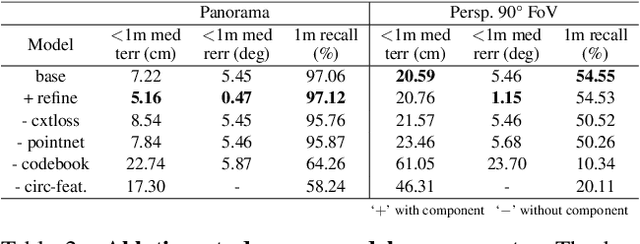Zhixiang Min
NeurOCS: Neural NOCS Supervision for Monocular 3D Object Localization
May 28, 2023Abstract:Monocular 3D object localization in driving scenes is a crucial task, but challenging due to its ill-posed nature. Estimating 3D coordinates for each pixel on the object surface holds great potential as it provides dense 2D-3D geometric constraints for the underlying PnP problem. However, high-quality ground truth supervision is not available in driving scenes due to sparsity and various artifacts of Lidar data, as well as the practical infeasibility of collecting per-instance CAD models. In this work, we present NeurOCS, a framework that uses instance masks and 3D boxes as input to learn 3D object shapes by means of differentiable rendering, which further serves as supervision for learning dense object coordinates. Our approach rests on insights in learning a category-level shape prior directly from real driving scenes, while properly handling single-view ambiguities. Furthermore, we study and make critical design choices to learn object coordinates more effectively from an object-centric view. Altogether, our framework leads to new state-of-the-art in monocular 3D localization that ranks 1st on the KITTI-Object benchmark among published monocular methods.
LASER: LAtent SpacE Rendering for 2D Visual Localization
Apr 01, 2022



Abstract:We present LASER, an image-based Monte Carlo Localization (MCL) framework for 2D floor maps. LASER introduces the concept of latent space rendering, where 2D pose hypotheses on the floor map are directly rendered into a geometrically-structured latent space by aggregating viewing ray features. Through a tightly coupled rendering codebook scheme, the viewing ray features are dynamically determined at rendering-time based on their geometries (i.e. length, incident-angle), endowing our representation with view-dependent fine-grain variability. Our codebook scheme effectively disentangles feature encoding from rendering, allowing the latent space rendering to run at speeds above 10KHz. Moreover, through metric learning, our geometrically-structured latent space is common to both pose hypotheses and query images with arbitrary field of views. As a result, LASER achieves state-of-the-art performance on large-scale indoor localization datasets (i.e. ZInD and Structured3D) for both panorama and perspective image queries, while significantly outperforming existing learning-based methods in speed.
VOLDOR-SLAM: For the Times When Feature-Based or Direct Methods Are Not Good Enough
Apr 14, 2021



Abstract:We present a dense-indirect SLAM system using external dense optical flows as input. We extend the recent probabilistic visual odometry model VOLDOR [Min et al. CVPR'20], by incorporating the use of geometric priors to 1) robustly bootstrap estimation from monocular capture, while 2) seamlessly supporting stereo and/or RGB-D input imagery. Our customized back-end tightly couples our intermediate geometric estimates with an adaptive priority scheme managing the connectivity of an incremental pose graph. We leverage recent advances in dense optical flow methods to achieve accurate and robust camera pose estimates, while constructing fine-grain globally-consistent dense environmental maps. Our open source implementation [https://github.com/htkseason/VOLDOR] operates online at around 15 FPS on a single GTX1080Ti GPU.
VOLDOR: Visual Odometry from Log-logistic Dense Optical flow Residuals
Apr 14, 2021



Abstract:We propose a dense indirect visual odometry method taking as input externally estimated optical flow fields instead of hand-crafted feature correspondences. We define our problem as a probabilistic model and develop a generalized-EM formulation for the joint inference of camera motion, pixel depth, and motion-track confidence. Contrary to traditional methods assuming Gaussian-distributed observation errors, we supervise our inference framework under an (empirically validated) adaptive log-logistic distribution model. Moreover, the log-logistic residual model generalizes well to different state-of-the-art optical flow methods, making our approach modular and agnostic to the choice of optical flow estimators. Our method achieved top-ranking results on both TUM RGB-D and KITTI odometry benchmarks. Our open-sourced implementation is inherently GPU-friendly with only linear computational and storage growth.
 Add to Chrome
Add to Chrome Add to Firefox
Add to Firefox Add to Edge
Add to Edge